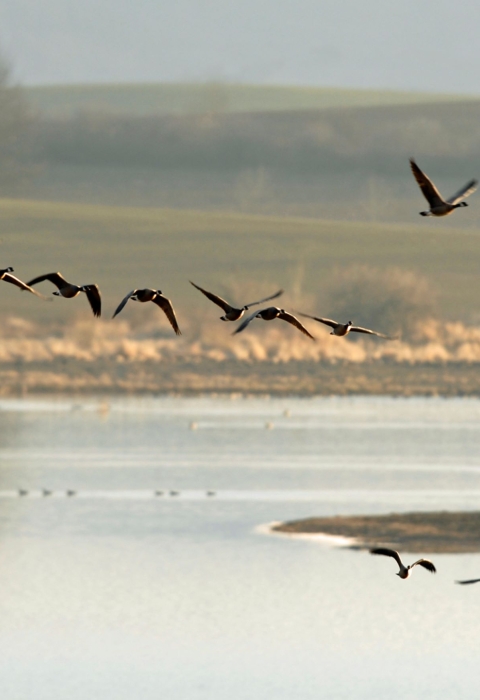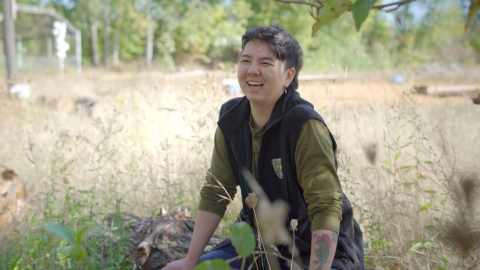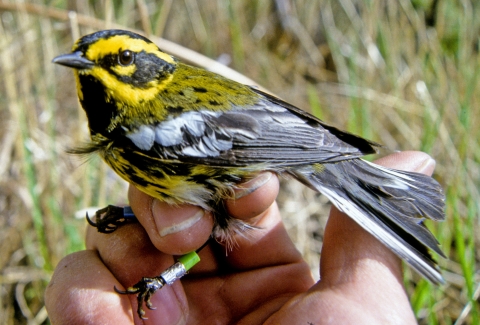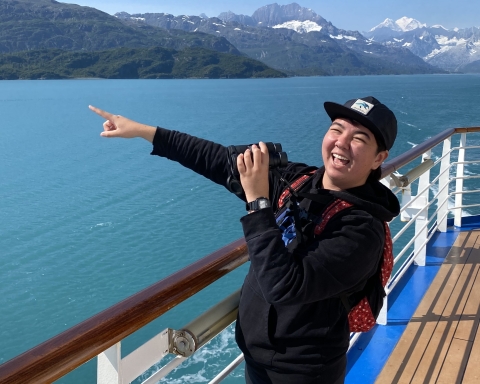Ollie Zanzonico didn’t go looking for a career in conservation. Their career in conservation found them — with a little help from a Townsend’s warbler.
The unexpected encounter happened in college, during a seven-week immersive field ecology course. Zanzonico didn’t really like being outside; when they were a kid, they were more the type to get in trouble for reading too late or for working on arts and crafts projects in the middle of the night.
“My parents tried to get me into outdoors stuff when I was a kid and every time they took me camping or hiking I hated it,” Zanzonico said. “I was really an inside kid.”
Zanzonico still cared deeply about the environment and used to dig recyclables out of the trash and ask family members to turn off water faucets if they’d been on too long. When Zanzonico attended University of California, Davis to get an environmental science degree, they took a field course for ecology credits.
“In the cohort of 30-something people, the people I really gravitated towards on a personal level were all birders,” Zanzonico said. “I remember I used a pair of really nice binoculars, and I think it was maybe the first time I had used binoculars to go bird watching.”
The first bird Zanzonico saw through those binoculars was a Townsend’s warbler – a beautiful, bright yellow bird with a cheery twitter. They were smitten.
“There was something about it where I was hooked, trying to figure out what the bird was in the book and hanging out with these really cool people and birding together and being outside,” Zanzonico said. “I’ve been a birder ever since.”
While looking for a way to build work experience while still in college, Zanzonico accepted a position with the Service’s Directorate Fellows Program at Kīlauea Point National Wildlife Refuge. They felt drawn working at the intersection of social science and environmental science, particularly on issues around climate change climate change
Climate change includes both global warming driven by human-induced emissions of greenhouse gases and the resulting large-scale shifts in weather patterns. Though there have been previous periods of climatic change, since the mid-20th century humans have had an unprecedented impact on Earth's climate system and caused change on a global scale.
Learn more about climate change and community planning.
“I was helping them plan logistics for moving to a shuttle and reservation system of entry for the refuge, rather than being able to drive in and park your own car at any time [in their extremely limited parking area],” Zanzonico said. “They were looking to manage overcrowding [as visitation has continued to increase] and the strain it puts on staff, wildlife and safety.”
Zanzonico graduated from college in 2020 at the height of the COVID-19 pandemic. It was a difficult time for Zanzonico and other recent graduates to find jobs. As a result of their work during the Directorate Fellow Program, they received a call from the supervisor of the Service’s Migratory Birds permit program in California, who encouraged them to apply for a job helping out with permits.
“I hadn't even put California on my list of states that I was willing to go to,” Zanzonico said. “I guess what I’m saying is that I got to my current position through a series of accidents. It’s like conservation found me.”
Zanzonico worked on permits in California for three years and kept their eye on jobs related partnerships and community. In 2023, they started helping with community events in support of their local urban wildlife refuge. Urban wildlife refuges are part of the Service’s Urban Wildlife Conservation Program, which works with communities to improve and increase access to nature, environmental education and opportunities to engage in conservation. The National Wildlife Refuge System and the Migratory Birds Program allocate approximately $7.7 million a year to scale local solutions to the broader wildlife conservation community. When the regional community outreach and engagement specialist position opened with Migratory Birds, Zanzonico knew that was their dream job.
“I really like that I do something new every day,” Zanzonico said. “There is always something new to learn and new people to talk to. I also really like how connected I feel. I feel like I’m a part of a community of people in the Fish and Wildlife Service. All of the people doing this work are really great, great people.”
As the community outreach and engagement specialist, Zanzonico still assists with permits and also serves as the Regional Urban Bird Treaty Program Coordinator. They coordinate birding outings and educational efforts with partners, including People of Color Outdoors and the Bird Alliance of Oregon.
“I want to be a lot more hands on in Portland,” Zanzonico said. “It’s the place where I live and work, the place where I bird, and I’m really involved in the birding community. I’m really excited to be more involved and hopefully leverage the connections I have to bring together partners under the umbrella of the urban bird treaty.”
Zanzonico’s long term goal is to find a way to make a meaningful difference for birds by engaging communities in conservation, especially historically underserved communities. Zanzonico’s journey reminds us that the most unexpected encounters—like that first glimpse of a Townsend's warbler—can lead to a profound passion for conservation.
“It's something that I really care about in a personal way, and I'm lucky that that really overlaps with my professional responsibility,” Zanzonico said. “I’m a really big fan of working in the community that I live in and wanted to have a position where I could see the real effects of the work that I was doing. I can feel that.”









